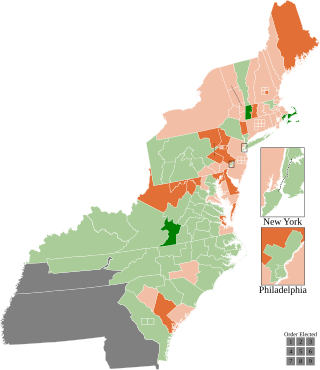Top Qs
Timeline
Chat
Perspective
1796–97 United States House of Representatives elections
House elections for the 5th U.S. Congress From Wikipedia, the free encyclopedia
Remove ads
The 1796–97 United States House of Representatives elections took place in the various states took place between August 12, 1796 (in North Carolina), and October 15, 1797 (in Tennessee). Each state set its own date for its elections to the House of Representatives. The size of the House increased to 106 seats after Tennessee became the 16th state to join the union. The first session of the 5th United States Congress was convened on May 15, 1797, at the proclamation of the new President of the United States, John Adams. Since Kentucky and Tennessee had not yet voted, they were unrepresented until the second session began on November 13, 1797.
Remove ads
Gains for the Federalist Party provided the president with a reliable majority in support of his policies. Many of the Federalist pick-ups in Congress came from the former Middle Colonies (New York, Pennsylvania, New Jersey, and Delaware). New England remained heavily Federalist, whereas the South and West favored Democratic-Republican candidates. Federalist trade and infrastructure policies found widespread approval in the Mid-Atlantic states during this era. With the growth of cities in Maryland, Pennsylvania, and New York, government intervention in the interest of industrialization and mercantilism became more attractive to voting citizens in these areas.
During this period, each state fixed its own date for a congressional general election. Elections to a Congress took place both in the even-numbered year before and in the odd-numbered year when the Congress convened. In some states the congressional delegation was not elected until after the legal start of the Congress (on the 4th day of March in the odd-numbered year).
Remove ads
Election summaries
Summarize
Perspective
During this period, each state fixed its own date for a congressional general election. Elections took place both in the even-numbered year before and in the odd-numbered year when a Congress convened. In some states, the congressional delegation was not elected until after the legal start of the Congress (on the 4th day of March in the odd-numbered year). The 1st session of the 5th Congress ran May 15 – July 10, 1797,[1] before the states of Kentucky and Tennessee had their elections, causing those states to be unrepresented in the 1st session.

| 49 | 57 |
| Democratic-Republican | Federalist |
Remove ads
Special elections
Summarize
Perspective
Elections are sorted by election date, then by district.
Fourth Congress
There were special and late elections to the 4th Congress in 1796.
Fifth Congress
There were special and late elections to the 5th Congress in 1797.
Remove ads
Connecticut
Summarize
Perspective

Connecticut elected its seven representatives at-large on a general ticket.
Remove ads
Delaware

Remove ads
Georgia

Remove ads
Kentucky

Remove ads
Maryland
Summarize
Perspective

Two of the four Democratic-Republicans were replaced by Federalists, bringing the Federalists from a 4–4 split to a 6–2 majority.
Remove ads
Massachusetts
Summarize
Perspective
Massachusetts's electoral law required a majority for election, necessitating additional trials in three districts.
Remove ads
New Hampshire
Summarize
Perspective

In 1796, New Hampshire had a single at-large district with 4 seats. Each voter cast 4 votes and a majority of voters (12.5% of votes) was required to be elected. Since only three candidates received a majority, a run-off was held between the candidates in fourth and fifth place to fill the remaining seat.
New Jersey

Remove ads
New York

North Carolina

Pennsylvania

Rhode Island

Rhode Island had an at-large district with two seats, each of which were elected separately.
South Carolina

Tennessee

Vermont
Summarize
Perspective

Due to Vermont's law requiring a majority to secure a congressional seat, the 1st district required three ballots to choose a winner.
Virginia

See also
Notes
- Date cited is the election date, but the new member in some cases "took" the seat on a later date.[2]
- The source used does not list votes for Powell, but provides a citations stating "Col. Powell of Loudoun was expected to have been a candidate on this occasion; but from the present ill state of his health, it was understood he had declined and consequently had but a few votes."[24]
References
Bibliography
External links
Wikiwand - on
Seamless Wikipedia browsing. On steroids.
Remove ads





